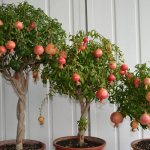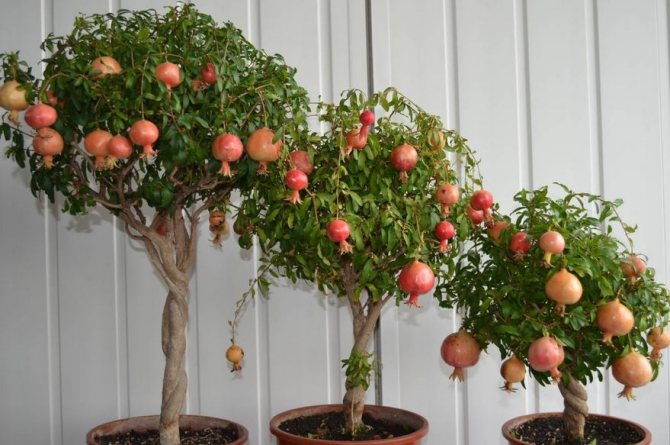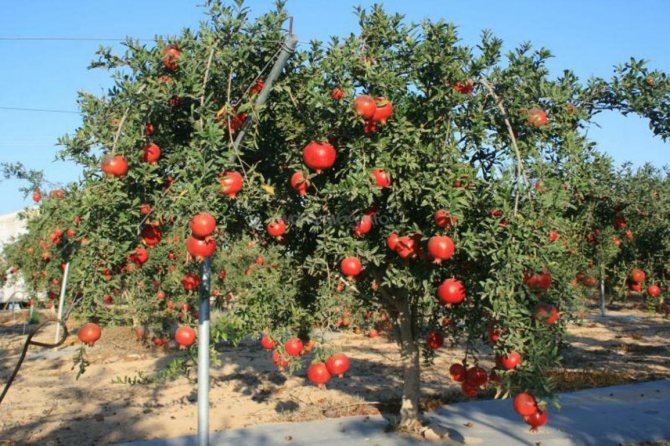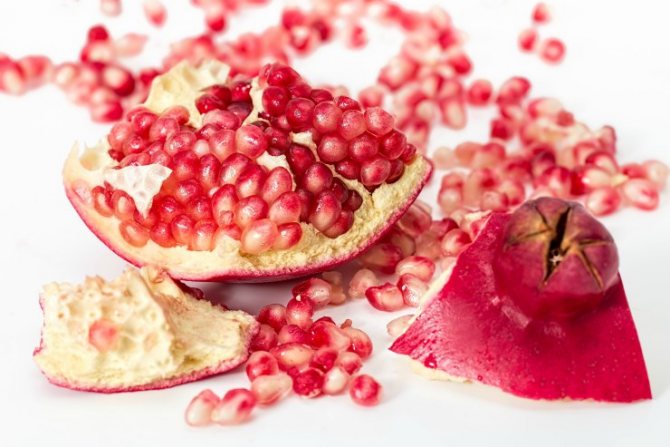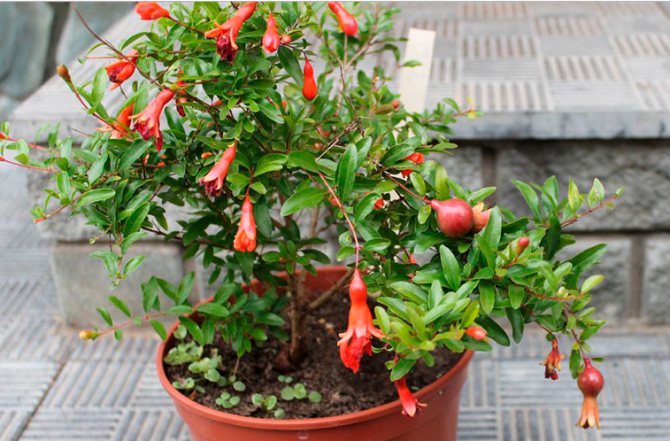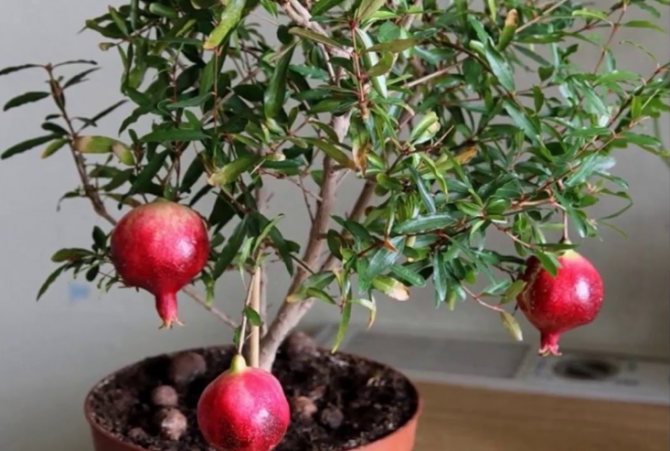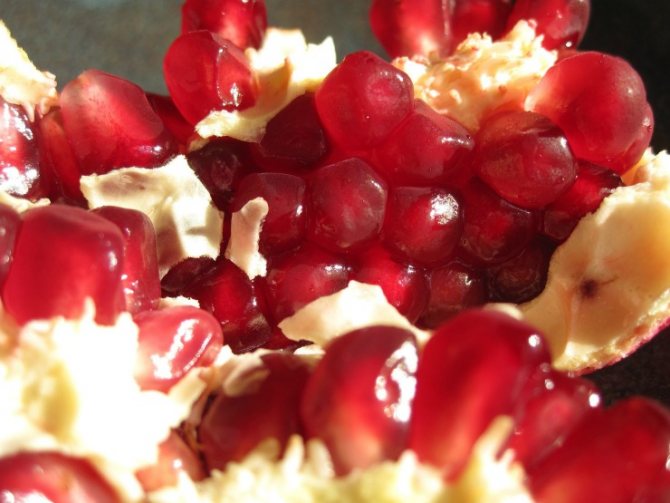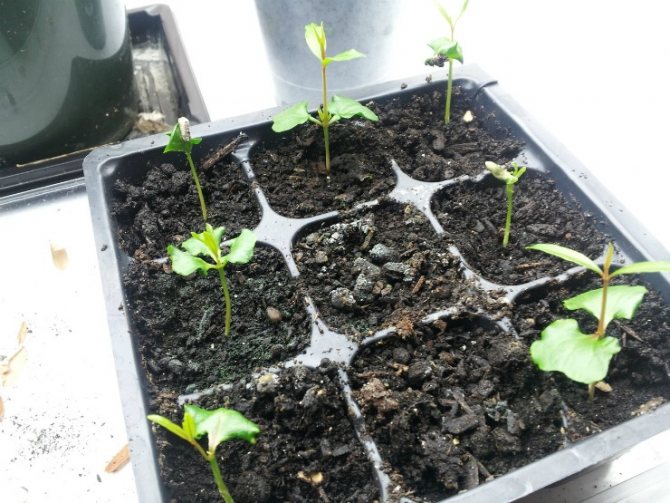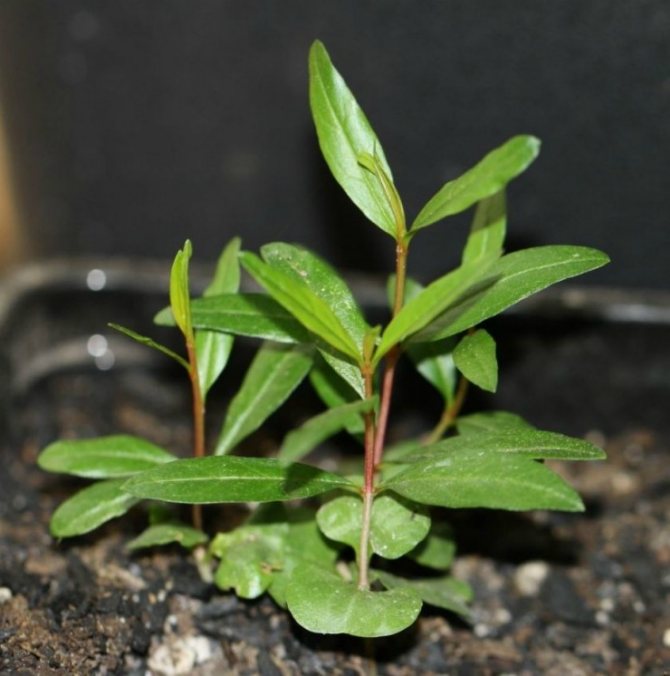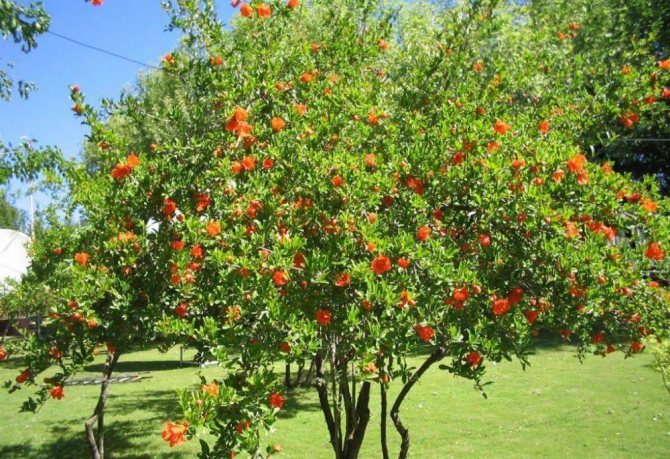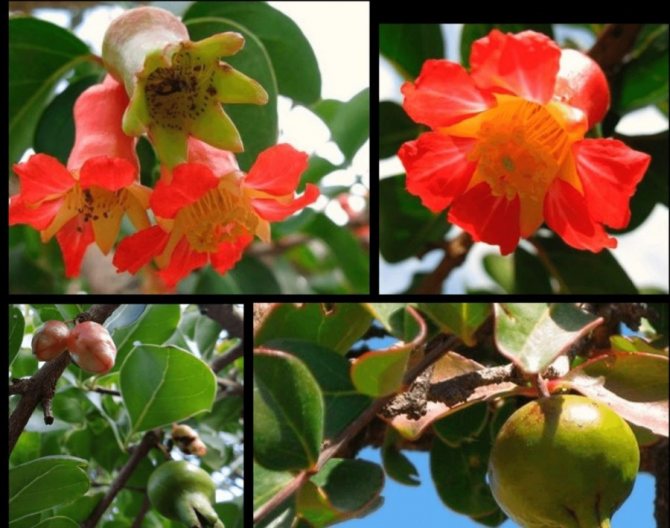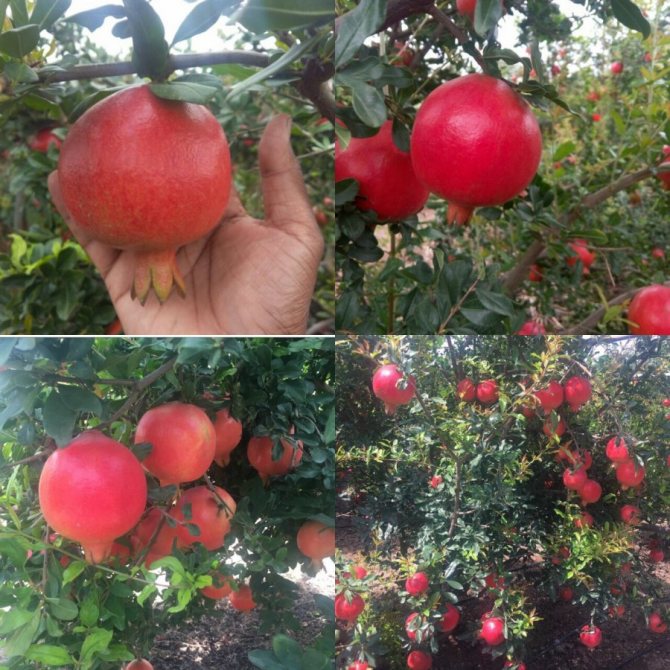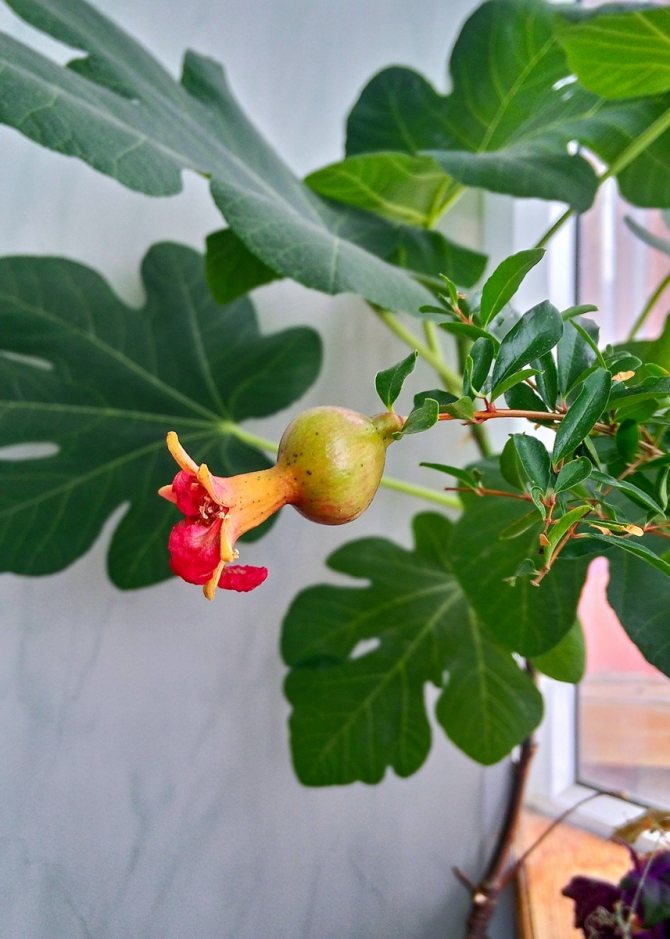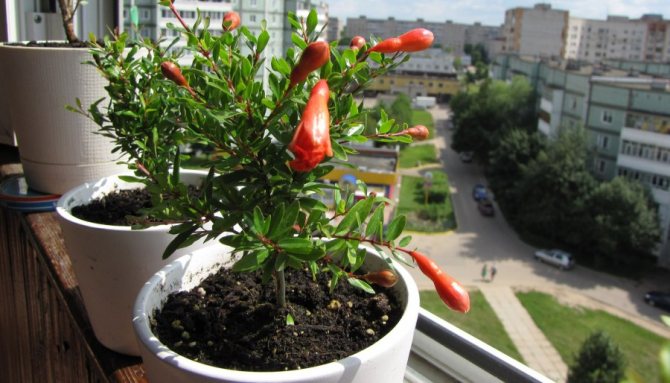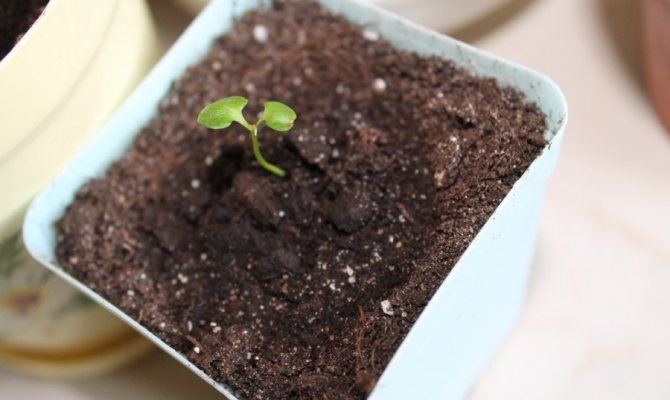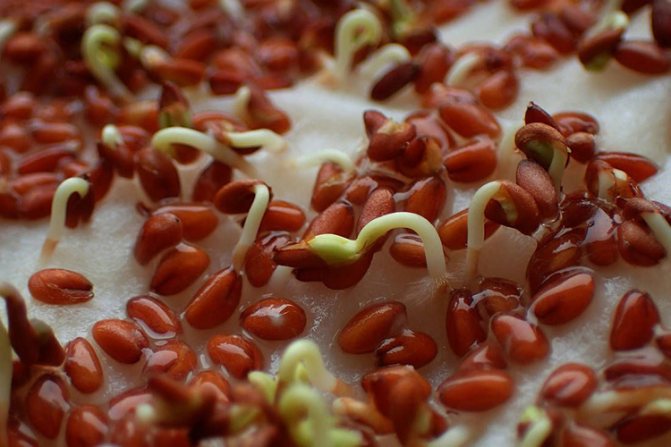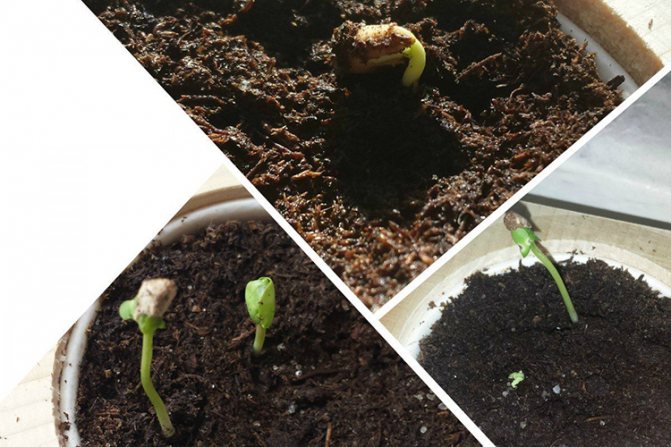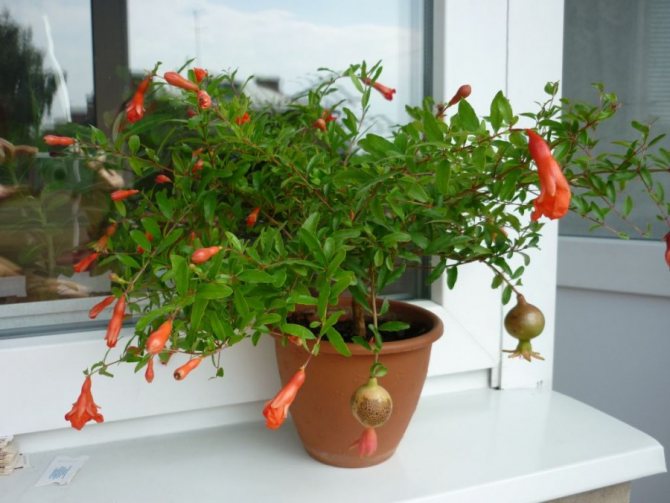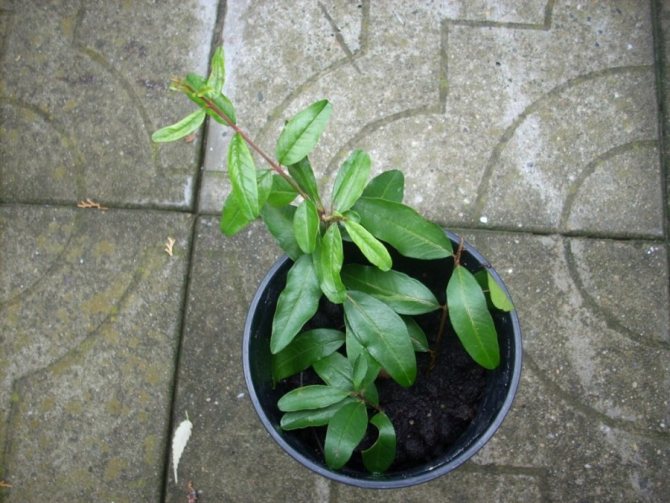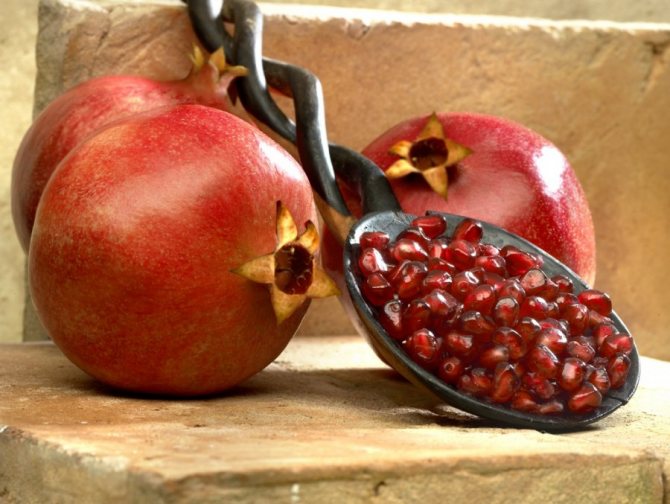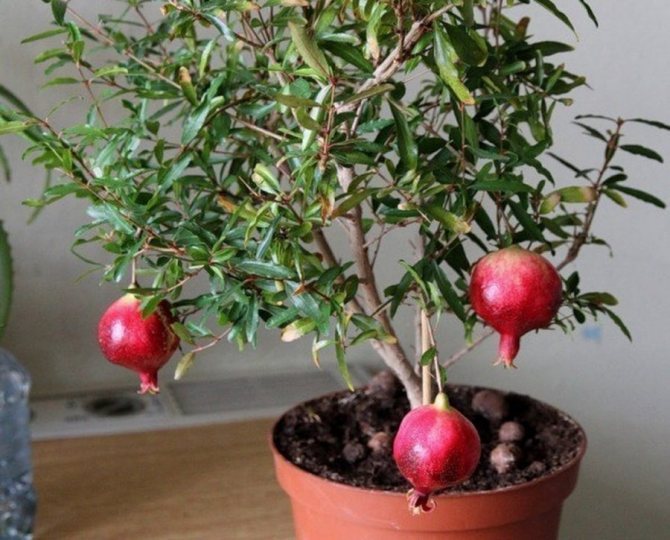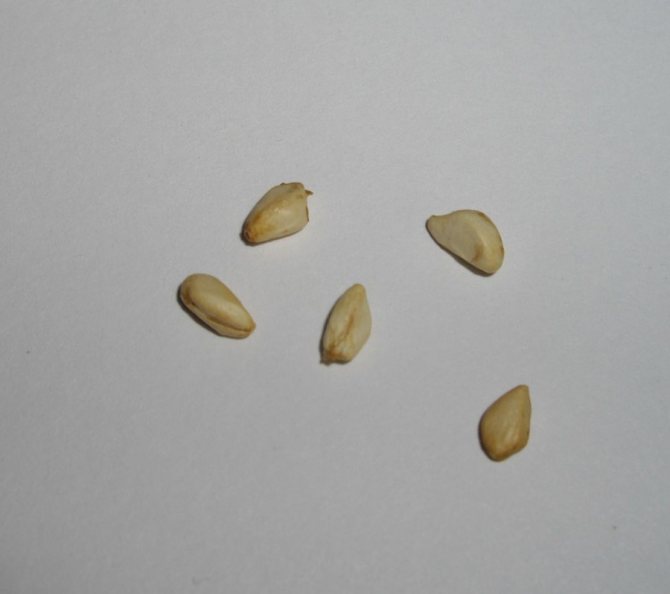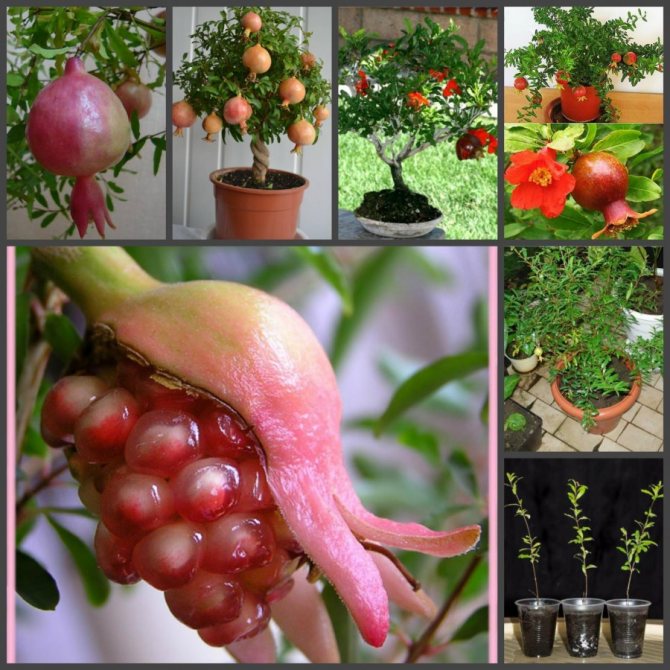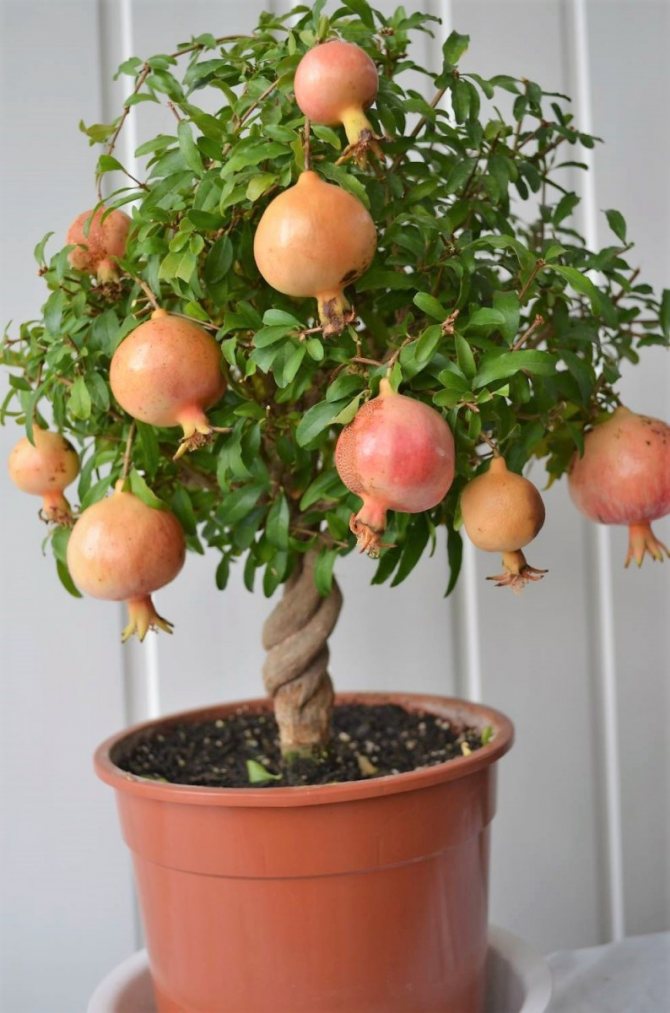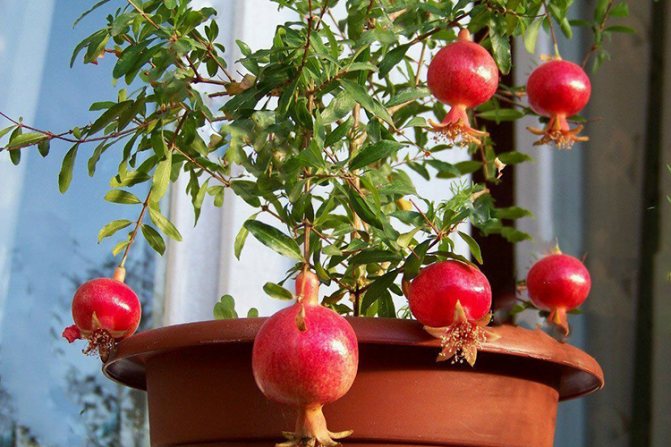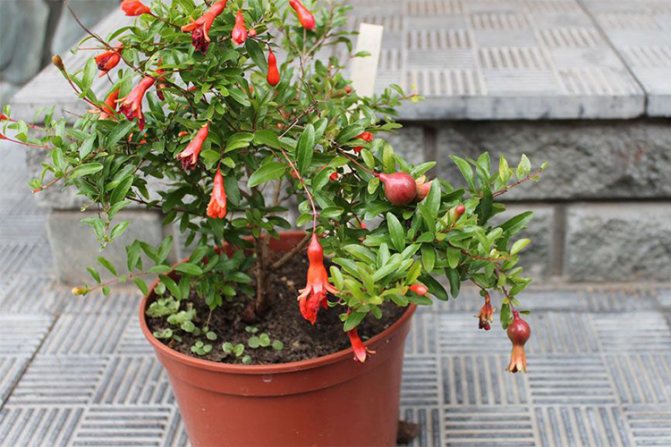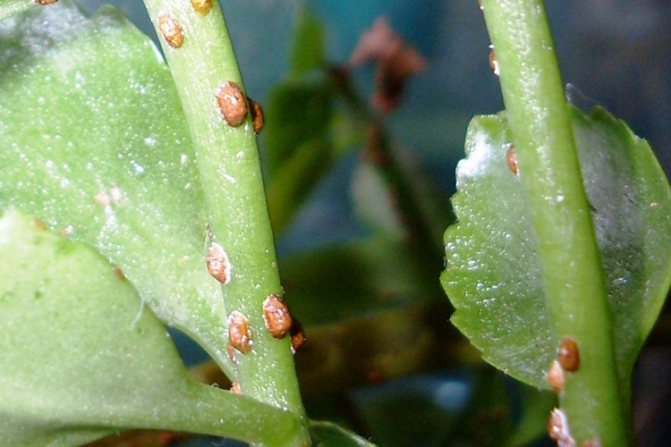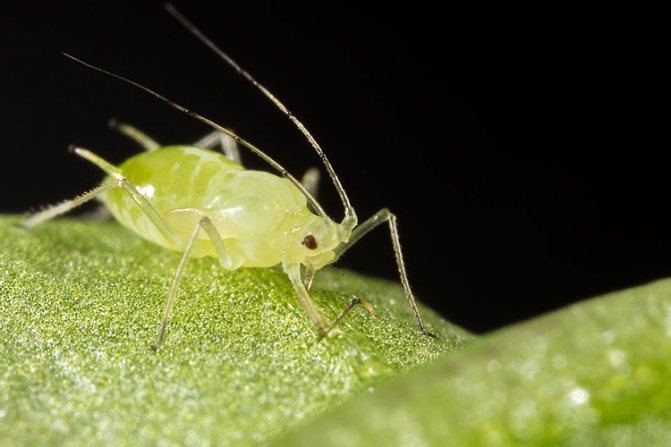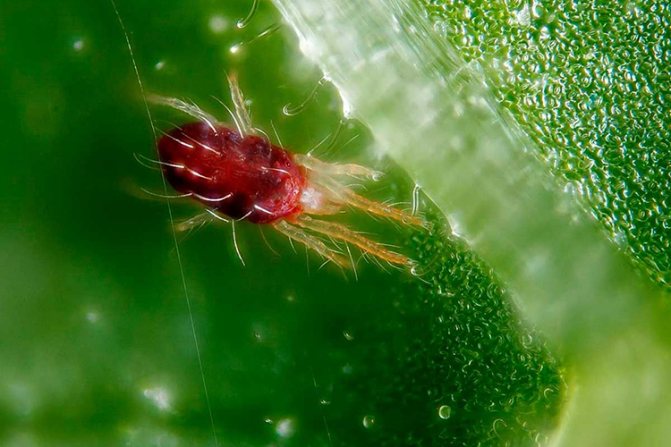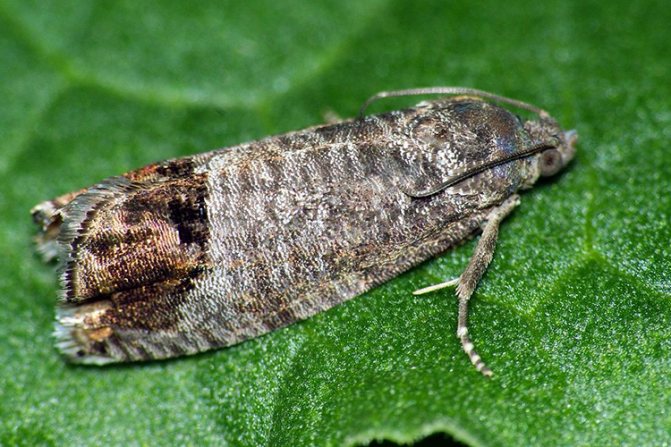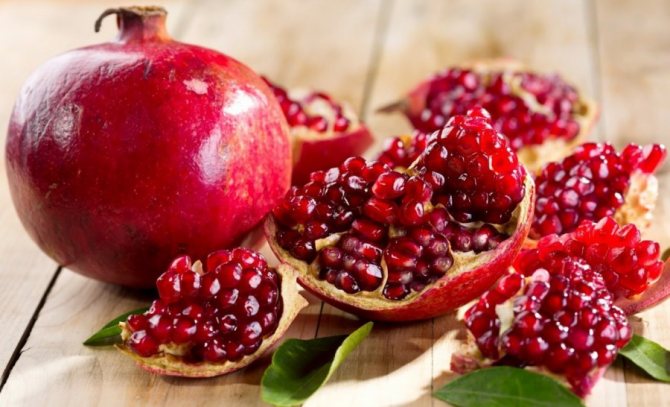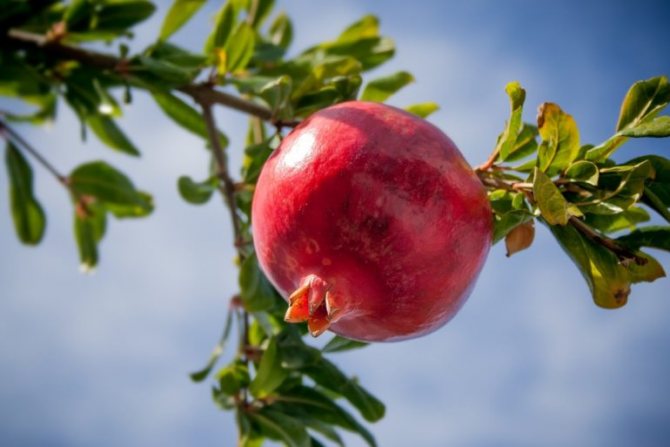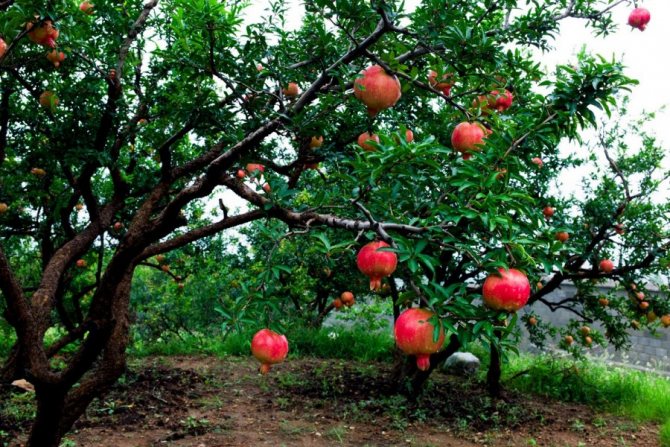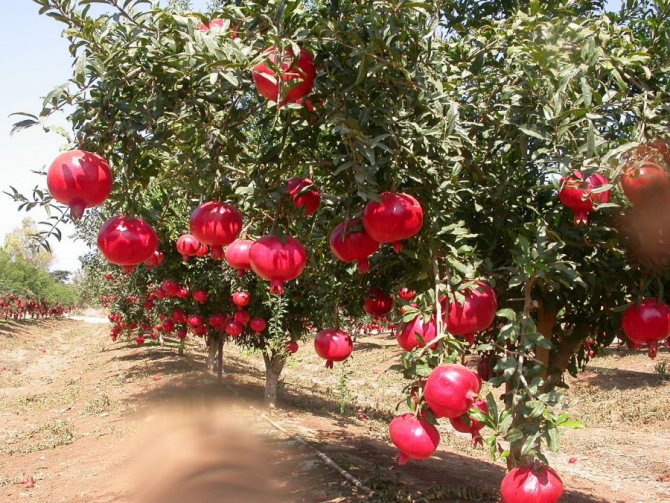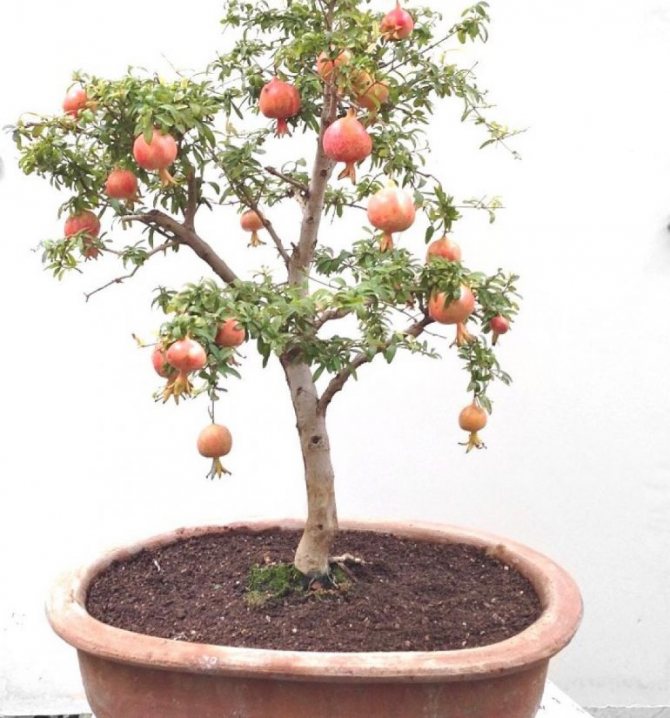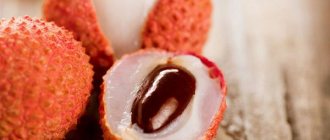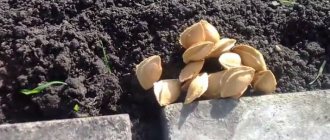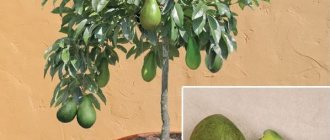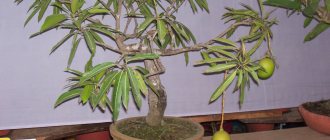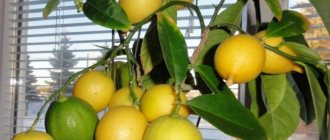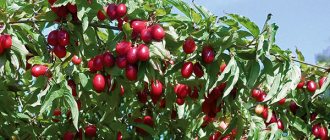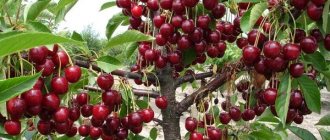Pomegranate (Punica) is a genus of trees from the Derbennikov family. Until recently, the family was called Garnet. Translated from Latin, Punica is Punic (or Carthaginian). This is due to the fact that the culture was widely grown in the territory of ancient Carthage, and "granatus" is translated as "granular".
Pomegranate is one of the most popular exotic plants that are cultivated at home. Low varieties of pomegranates are even grown in apartments. It is unpretentious to care for, withstands aridity, but requires a lot of light. You can even grow a pomegranate tree from a bone. But if you want to get the fruits, you have to make some effort.
How and where pomegranate grows in natural conditions
The natural environment for pomegranates is sandy and rocky areas, which are found in the tropics and subtropics. The birthplace of culture is the Mediterranean coast, the northern part of Africa. Today, more than 100 varieties of pomegranate are domesticated, cultivated on an industrial scale in Tunisia, Egypt, Italy, Spain, Turkey, the Caucasus, and Central Asia.
In open ground, the tree grows up to 5-6 m. In winter, the plant can withstand temperatures down to -5..15 ° C. At –20 ° C, the pomegranate dies. A high yield can be obtained with sufficient air humidity. Although the pomegranate can withstand drought. The fruits begin to ripen from the beginning of October. The timing depends on the variety and climate where the tree grows.
The most popular garden varieties:
- Kizil-anor;
- Guleisha;
- Shah-nar;
- Nazik-kabukh.
Seed preparation
Pomegranate grows well both at home and outdoors. However, to grow a plant in a garden, you must either have a plot in the southern regions of Europe or Western Asia, or use frost-resistant varieties. In the middle lane, planting and further caring for a pomegranate in the open field is a rather troublesome task that often does not bring the expected results.
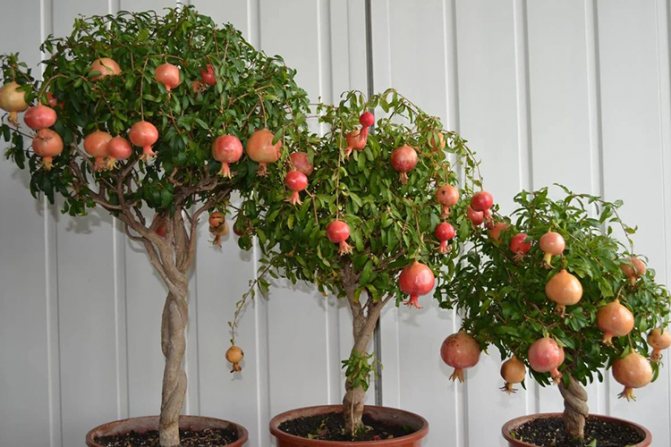
Therefore, the easiest way is to plant a pomegranate from a stone by making an exotic mini-garden on your windowsill. To do this, you must use seeds purchased from a gardening store, or obtained from a ripe fruit.
In garden shops, in addition to seeds, they sell ready-made seedlings or young trees, which greatly simplifies the task.
If the goal of the gardener is to grow pomegranates from scratch, then you need to go to the market or to the supermarket for ripe fruit. Bones are removed from the fruit, which are used as planting material.
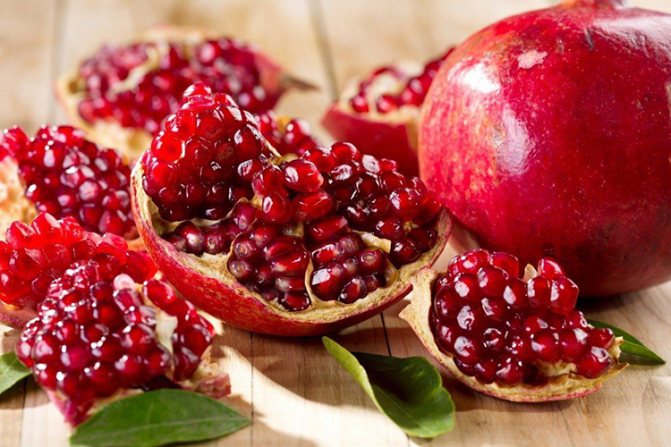

When growing a houseplant, its fruits will not have the same taste as the parent fruit, since hybrid plants are used for sale.
From the pomegranate, you need to get seeds in the amount of 15-20 pieces, depending on how many trees the gardener plans to plant. The bones should be milky or light beige in color, without visible damage. Seeds that are green, dark, or spoiled (rotten) are not suitable for growing.
The bones with pulp are placed in a glass saucer and poured with a small amount of purified or filtered (but not boiled) water. The liquid should cover the seeds. The dish is left alone for 10-12 hours (preferably overnight).In the future, the seeds are cleaned of pulp and start planting.
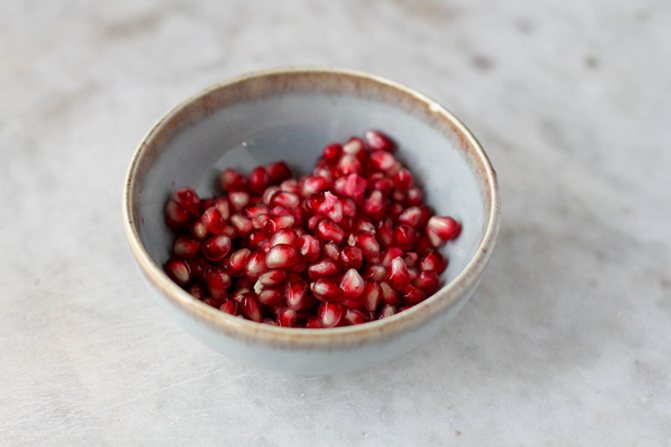

A few drops of a ready-made biostimulant based on natural compounds can be added to the water.
Another method involves cleansing the seeds from the pulp before immersing them in liquid. It will also be effective. The seeds can even be dried and used for planting within six months, but in this case, their germination is reduced.
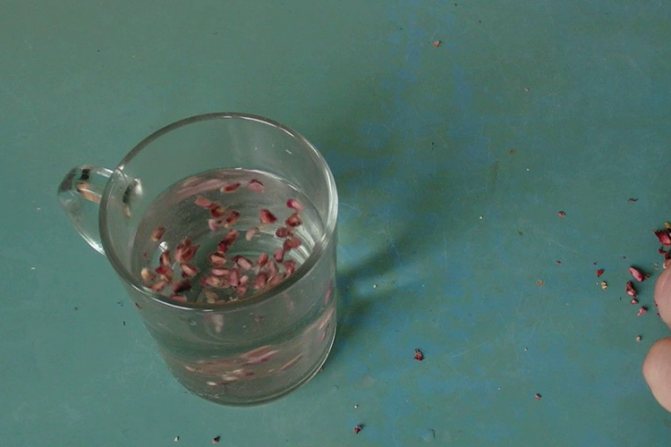

How to choose a fruit for planting a seed
For home cultivation, choose low-growing pomegranates, which can be planted in a pot, of the following varieties:
- Nana,
- Baby,
- Carthage.
The trees grow on average 40-100 cm in height.
You can buy pomegranate for collecting seeds at the store. But there is no guarantee that a tree will grow from them with the same fruits that the mother tree gives. As a rule, they sell hybrid varieties of pomegranate, the seeds obtained from them do not completely retain their parental characteristics.
If you still want to collect the seed yourself, you need to choose the right fruit. The guarantor must be large, undamaged, fully ripe. From rotten fruits, the seeds have poor germination.
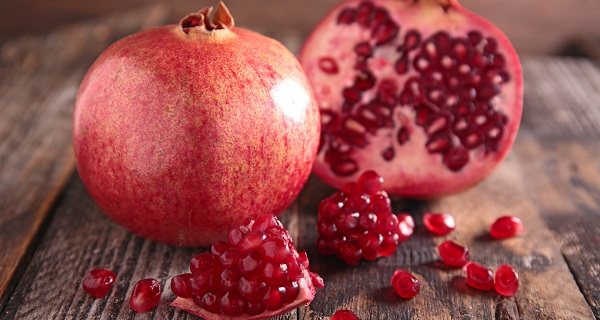

How to grow from a seed
Ripe seeds are white or creamy and hard to the touch. Soft and green seeds are discarded. If you buy ready-made seeds, then you need to do this in specialized stores. Read the information on the packaging carefully. It should contain as much information as possible about the manufacturer and the characteristics of the variety. Planting seeds is best done in winter, so that shoots have already appeared by spring.
Preparation of the bone
If the seeds are harvested from the fruit, they need to be peeled from the pulp and rinsed well. Leave to dry for 10 hours. To speed up germination, seeds are germinated in advance. The bones are dipped in a growth stimulator (Epin) for 12-20 hours. They can be wrapped in damp gauze or soaked in a saucer. But they should only be half-covered with mortar. It is necessary to allow the seeds to breathe. Transfer to a cool place. Monitor the water in the container. If necessary, add it so that the bones do not dry out and do not crack.
Soil preparation
Pomegranate is unpretentious to the composition of the soil. The main thing is that it is loose and fertile. You can buy the substrate at the store or make it yourself. To plant seeds, a composition of equal parts of peat and sand is suitable. You can mix in equal parts turf, sand, leafy soil and half the amount of humus. Before use, it is recommended to pour over the sand with boiling water for disinfection.
Landing rules
For planting seeds, prepare a wide pot with a depth of about 10 cm. The material can be any. But it is better to use a clay container. Lay a drainage layer on the bottom (expanded clay, polystyrene, pebbles). Pour in soil, moisten it. Make depressions 1-1.5 cm. Lay out the seeds, sprinkle with soil. Sprinkle with water and cover with foil. Move the pot to a warm, dry place. Once a day, remove the film for a few minutes, ventilate the "greenhouse". Water as needed. After the first leaves appear, the film can be removed. But this should be done gradually. Temper the sprouts, give them the opportunity to adapt to the surrounding conditions.
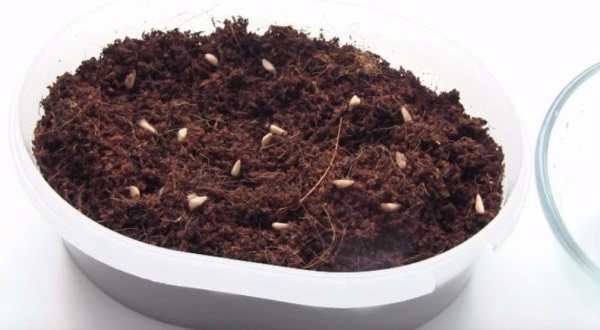

Propagation of pomegranate cuttings
A pomegranate cut from a cut produces fruit much earlier than a seed-derived pomegranate. The most common way to breed a pomegranate tree is as follows:
- thin, slightly lignified cuttings with 4 internodes are cut from annual shoots to a length of 10-15 cm;
- pretreated in a stimulator, the branches are planted in a moistened earthen substrate with vermiculite and sand with a depth of 2 internodes;
- greenhouse conditions are organized: greenhouse, subsoil heating up to 23-25 ºС, regular ventilation.
The appearance of processes occurs after about a month, as evidenced by the presence of young buds.Since the pomegranate is rather reluctant to root, planting several cuttings at the same time is recommended for a guaranteed result.
An alternative way of growing a tree is by rooting the shoots in water. For this method, pomegranate cuttings are cut to a length of 5 cm, then placed in sterile water and placed in a secluded place, protected from direct sunlight and drafts. The most favorable time for root germination in this way is late spring, early summer.
How to care
Taking care of the pomegranate tree is easy. To grow it without problems and achieve fruiting, you need to adhere to some rules.
Location and lighting
Pomegranate loves light. Therefore, you need to place it in a well-lit place. But remove from direct sunlight so that the leaves do not burn. Daylight hours for a pomegranate should last at least 10 hours. Therefore, in winter, to provide additional lighting, it is recommended to illuminate the plant with a fluorescent lamp. With a lack of light, it will grow poorly. In the summer, it is imperative that the pot with the tree be exposed to fresh air in diffused light.
Temperature
In order for the seeds to germinate, they need a temperature of + 25..30 ° С. The growing tree should be kept within + 18..25 ° С. In winter, when it sheds its leaves, transfer it to a cool room with a temperature of no more than + 12..15 ° C. But it is better to keep the pomegranate at + 7 ° C to ensure a dormant period. After the end of the frost in the spring, the plant can be taken out to the balcony or veranda.
Watering and moisture
Pomegranate loves moisture. It is better to spray young seedlings instead of watering. Water mature plants abundantly and regularly. On average, pomegranate is watered once a week. But if it is very hot, then the amount of watering can be increased. If the soil is dry to a depth of 1-2 cm, the tree can be watered. Water for irrigation should be soft, at room temperature. For watering, it is better to use a watering can with a long spout so that the water gets into the ground, and not on the trunk. After watering, drain the water from the pallet so that it does not stagnate.
On a note! To create tropical conditions during the period of active growth, it is recommended to spray the foliage from a spray bottle 2-3 times a week. In hot weather, it is recommended to do this more often. It is better to spray the pomegranate in the morning or evening. If you moisturize the leaves during the scorching sun, they can get burned.
Fertilizers and feeding
From spring to autumn, pomegranates are fed 1-2 times a month. Nitrogen fertilizers are applied in the spring. They stimulate the growth of green mass. When a tree is in bloom, it needs phosphorus. Closer to autumn, potash fertilizers begin to be applied. But you need to use mineral fertilizers very carefully. They contain nitrates, which will subsequently enter the fruit if the tree bears fruit.
The best means for feeding a fruiting pomegranate is organic. For example, during the period of fruit ripening, the plant can be watered with a weak solution of chicken manure (1:25). Any dressing can be applied only after watering, to avoid scalding the roots.
Pruning and shaping the crown
To form a pomegranate with a branchy crown, it must be pinched regularly. The first pinching can be done while picking young seedlings by pinching the tops slightly. It is recommended to remove the crown after the appearance of 4 pairs of leaves. This makes it possible to avoid pulling the stem and stimulates the growth of lateral shoots. Then the procedure is carried out when there are already 4 pairs of leaves on the lateral stems.
To form a lush crown, it is necessary to carry out an annual haircut with a pomegranate. The optimal time for this is before the start of the awakening, that is, in February.
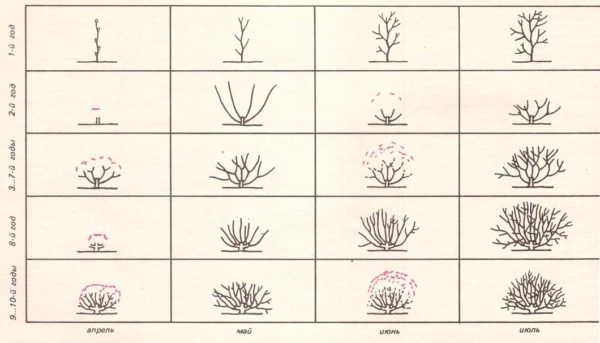

Pruning rules:
- leave 5 skeletal branches;
- trim over the bud that grows outward;
- remove all thin stems over 4 years old;
- cut off the lower shoots.
The crown can be formed in different shapes, according to your taste.A pomegranate tree lends itself well to bonsai formation. To do this, the tree is grown in one branch, regularly pinching it, bending young shoots in the right direction with the help of a wire. You must also remember to remove dry branches and leaves from the tree.
Transfer
The first time you need to transplant the plant when a pair of real leaves appear on the sprouts. Saplings dive into separate pots. They should not be deep, since the root system of the pomegranate is shallow. Until the age of 5, the culture needs an annual transplant. Older specimens are moved to a new pot every 3-4 years. It is difficult to replant mature trees. Therefore, it is recommended to replace the topsoil with 2-3 cm more nutritious soil annually.
It is better to choose earthen pots, always with drainage holes. The soil can be taken universal; for greater looseness, add sand or vermiculite to it.
Transplant procedure:
- Pour a drainage layer into the container so that it covers the bottom. Add soil to about half of the pot.
- Carefully remove the plant from the old container without damaging the earthen lump.
- Place the bush in the center of the new pot, top up the soil. Tamp it down slightly.
- Drizzle with warm water and transfer to a bright place.
Bloom
If you properly care for the pomegranate tree, then the first flowers may already appear a year after planting. Homemade pomegranates can bloom several times a year and bear fruit. But the first 2-3 years, flowers must be removed. The harvest can only be obtained when the tree is strong.
The culture forms 2 types of flowers - with a long and short pistil. The fruits are formed from flowers with a long pistil. But for this to happen, pollination must take place. The procedure can be carried out independently with a cotton swab. Hybrid varieties already have the ability to self-pollinate. The percentage of self-pollination varies between 5-20%.
Dormant period
At the end of autumn, the pomegranate begins to shed its leaves, which indicates the onset of a dormant period.
In order for a plant to have the strength for active growth in spring, it needs to organize the right conditions:
- Transfer to a cool room with a temperature of about + 7 ° C.
- Water only when the topsoil is completely dry, on average 2 times a month or less.
- Do not spray the plant.
- Do not fertilize until February.
Sometimes a pomegranate is organized a warm winter and it continues to grow. But such conditions will affect the further development of the tree and its fruiting. Therefore, a rest period is necessary for the grenade.
Homemade pomegranate tree - description, photo
Home grown plant reaches a height of only 90-100 cm... The exotic pet blooms profusely and constantly. The tree is simply strewn with bright flowers that bloom both in inflorescences and singly.
The pomegranate grown from the seed will bloom and will bear fruit no earlier than three years after planting.
For a pomegranate tree, you need to choose a bright place. The plant loves bright, but diffused light. Direct sunlight will burn the leaves. Therefore, the tree grown on the southern windowsill must be shaded from the midday sun.
Is it possible to get fruits at home and how to do it
If you grow pomegranate from a seed, then the probability of preserving all the qualities of the mother tree in it is very low. If the seed was taken from an ordinary store fruit, then the tree will be able to bear fruit only at 7-8 years of age. To get full fruit as early as possible, it is recommended to be vaccinated. There are many methods of grafting a tree. The most popular is copulation. Its essence lies in the fact that on the rootstock and scion they make the same oblique cut and connect them for accretion.
Grafting Algorithm:
- Moisten the stock with a clean cloth. Make an oblique cut with a sharp knife at an angle of about 25 degrees.
- Make the same cut on the handle, stepping back 1 cm under the lower kidney.
- Connect the rootstock and the scion so that the slices match.
- Wrap the joint with foil or elastic tape. The parts to be joined must not move.
- Lubricate the stalk on top with garden pitch.
The vaccination is successful if fusion occurs and the buds begin to grow. Such a tree will begin to bear fruit in 3-4 years.
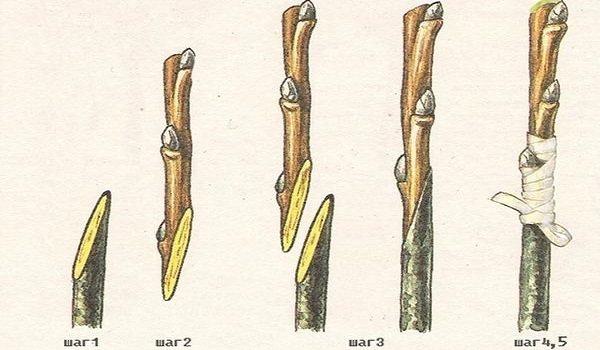

Seedling care
When shoots appear, you need to rearrange the pot to the lightest window. The ideal place is the southern windowsill. But take your time to remove the package. You must first harden the seedlings. Do this gradually, removing the cover for an hour at first, then gradually lengthen the time.
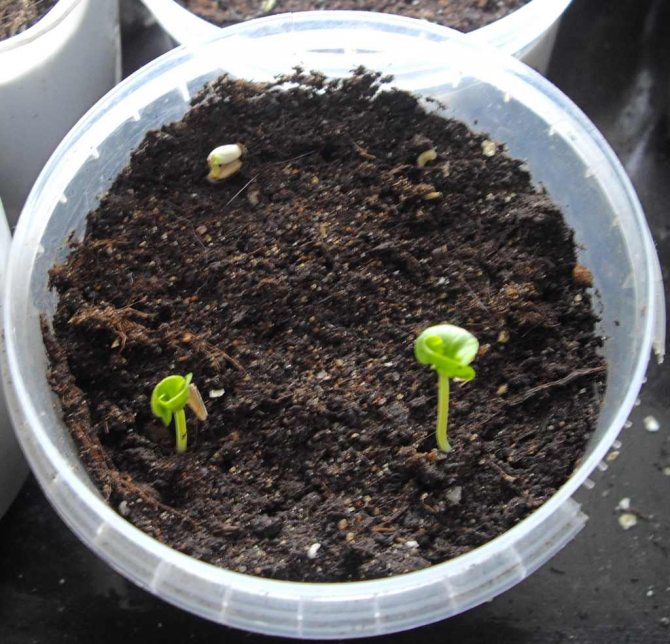

When shoots appear, the shelter is gradually removed.
Water as needed - do not overfill, but also do not let the soil dry out too much. You can spray, but do not overdo it.
Important. For watering and spraying pomegranates, use only settled water, the temperature of which is 2-3 ° C higher than room temperature.
The temperature in the room where the small pomegranate grows and gets stronger, it is advisable to maintain within the range from 18 to 25 ° С... The room must be periodically ventilated, but during this time the pomegranates must be removed from the draft.
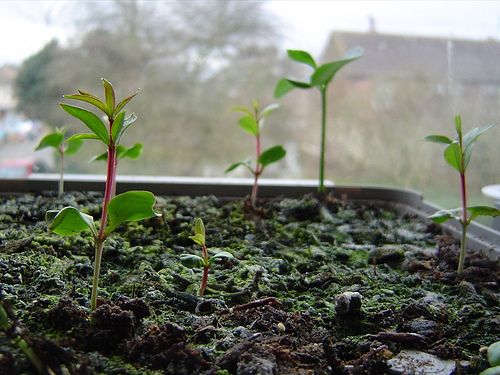

Pomegranate seedlings grow very quickly if they are in comfortable conditions.
Picking
A pick is carried out after the seedling has 3-4 true leaves... For the procedure, choose only the strongest plants. It will not be possible to grow healthy trees from the weak. During the picking, the central root of the seedling can be slightly pinched. This will allow the plant to grow more suction lateral roots, due to which the ability to absorb nutrients and moisture will increase.
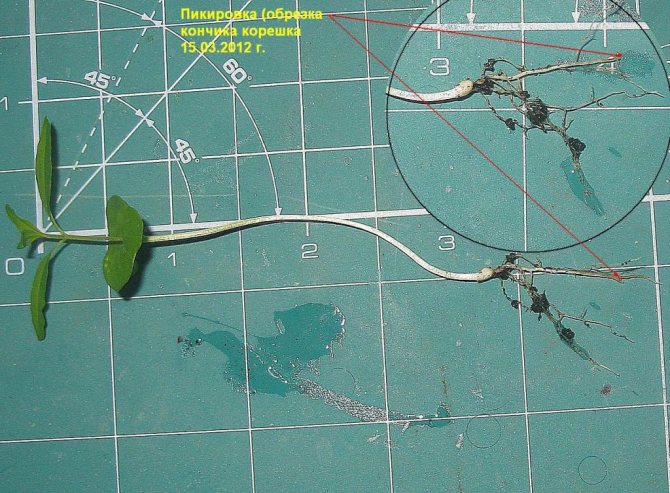

During the dive, you can slightly pinch the root

